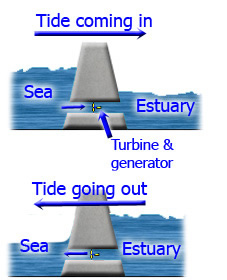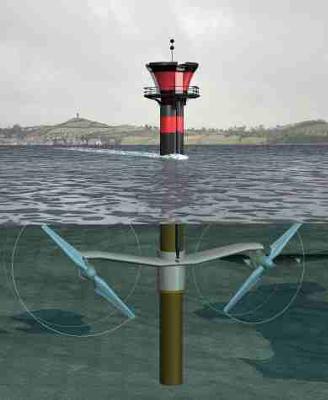Wave
and tidal energy generation methods, while somewhat behind other more well
known generation sources in terms of technological development (e.g. wind), do
have the potential to generate significant amounts of renewable energy. As the
names suggest, wave energy generation differs from tidal generation in that
wave energy utilizes the mechanical power of waves to generate energy and tidal
generation uses tidal fluctuation for generation. With respect to Newfoundland
and Labrador, while there is no current development plans aiming to establish a
wave or tidal energy generation farm, these forms of renewable energy
generation have been acknowledged as future possibilities for our province (See
Future Energy Plan). Therefore, a quick look at what environmental and
conservation implication this type of development may have for a location which
would bear such a farm is valuable.
When considering tidal energy
projects, there are two types of tidal energy systems in use at present. The
first of these is termed the tidal barrage or fence and is essentially a energy
generation structure which works similar to the hydroelectric dam except that
water can flow through both ways (See Figure 1). The second tidal generator
type is termed the tidal stream generator, and these are placed directly into
the water column as interconnected or stand alone structures (See Figure 2). A study by Andonegi et al. (2012) shows that tidal barrage systems have a wide range of effects including:
the alteration of tidal range patterns, immediate benthic habitat destruction
and possible damage to adjacent areas, shifting in range of marine and tidal species,
significant alteration of sea bird food availability causing possible detriment
to reproduction and survival, and have a high potential for fish entrainment.
When comparing the tidal stream system to the tidal barrage system, we see a lessened
amount of negative impacts on many species (e.g. fish, marine mammals, sea birds)
while significant impacts on water flow, wave, and sedimentation patterns, and some
scouring and altered depositional patterns are retained to a lesser degree. With regards to seabirds, the impacts of these techniques of energy generation are tied closely to the species' methods of foraging, flight behaviour, and susceptibility to environmental fluctuations (Langton et al., 2011).
 |
| Figure 1: Mechanism of Tidal Barrage/Fence Energy Generation System. Obtained from: http://www.darvill.clara.net/altenerg/tidal.htm |
 |
| Figure 2: Artist rendition of tidal stream energy generator. Obtained from: http://www.anglesey-today.com/skerries-tidal-energy-lease-granted.html |
When considering the wave energy
generation structures, we see a much less developed technique of energy
generation with a number of energy generation equipment forms. For example, one type of energy generator used just off the Portuguese Coast in the Agucadoura wave park is the floating generator which (Figure 3). One example of how diverse the technology is shown in the Wave Hub (Figure 4) project of SW England which is a project allowing the connection of four different wave energy generators to the same hub. Due to the relative infancy of wave energy technology, there is very little empirical information on how these generator types impact the environment in which they are deployed. However, Witt, et al. (2012), in their review of potential impacts these generators may have, stated that among others, there may be possible electromagnetic disturbances from undersea cables as well as anthropogenic sound disturbance especially in the construction and maintenance of the devices.
 Figure 3: Pelamis wave energy generator located within Agucadoura wave park, Portugal. Obtained from: http://upload.wikimedia.org/wikipedia/commons/thumb/4/4b/Pelamis_at_EMEC.jpg/800px-Pelamis_at_EMEC.jpg |
 |
| Figure 4: Diagram of Wave Hub energy generation project in SW England. Obtained from: http://www.wavehub.co.uk/wp-content/uploads/2011/02/wave-hub-schematic.jpg |
So, while Newfoundland and Labrador have not yet made any significant advance in the development of any tidal or wave form of energy development, the technology is out there and it does remain a possibility for our province since we do live on an island after all. If in the future we do move towards the implementation of tyis type of project, it is this information which we need to aid in the decision of what type of generator, where they should be placed, and what type of conservation and environmental impacts they may have which need to be addressed.
For more information have a look at these!
Future Energy Plan
Wave Hub
Ocean Energy Council page on Wave and Tidal Power
References:
Frid, C., Andonegi, E., Depestele, J., Judd, A., Rihan, D., Rogers, S.I., and Kenchington, E. (2012). Then environmental interactions of tidal and wave energy generation devices. Environmental Impact Assessment Review. Vol. 32, Pgs. 133-139.
Langton, R., Davies, I.M., Scott, B.E. (2011). Seabird conservation and tidal stream and wave power generation: Information needs for predicting and managing potential impacts. Marine Policy. Vol. 35, Pgs. 623-630.
Witt, M.J. et al. (2012). Assessing wave energy effects on biodiversity: the Wave Hub experience. Phil. Trans. R. Soc. Vol 370, Pgs. 502-529.
Wave Hub
Ocean Energy Council page on Wave and Tidal Power
References:
Frid, C., Andonegi, E., Depestele, J., Judd, A., Rihan, D., Rogers, S.I., and Kenchington, E. (2012). Then environmental interactions of tidal and wave energy generation devices. Environmental Impact Assessment Review. Vol. 32, Pgs. 133-139.
Langton, R., Davies, I.M., Scott, B.E. (2011). Seabird conservation and tidal stream and wave power generation: Information needs for predicting and managing potential impacts. Marine Policy. Vol. 35, Pgs. 623-630.
Witt, M.J. et al. (2012). Assessing wave energy effects on biodiversity: the Wave Hub experience. Phil. Trans. R. Soc. Vol 370, Pgs. 502-529.
Hi, interesting blog. I have read an article however explaining many difficulties within this energy source. Ferro, the author of the article quotes "Most of this resource is currently technically inaccessible or located far away from human settlements; hence only 10 to 25% of electricity may be realistically generated by wave and tidal. However, we believe the investment required to extract this power from the oceans would exceed £600 billion".
ReplyDeleteTherefore it is expensive for little energy. The paper also explains many other problems with this energy method.
I believe that it has great expectation though and we are on a good start in maintaining a base in renewable energy and I do think NL should get started as we have very good conditions for it.
Reference:
Ferro,B. (2006). Wave and tidal energy: Its Emergence and the Challenges it Faces, Refocus,7,3 46-48, ISSN 1471-0846, 10.1016/S1471-0846(06)70574-1.
(http://www.sciencedirect.com/science/article/pii/S1471084606705741)
Yes, I agree with the author of the paper you found, in that there is not as much potential energy in this generation strategy. However, this is a very new technology, so there is much room to develop cheaper and more efficient generation techniques.
ReplyDelete